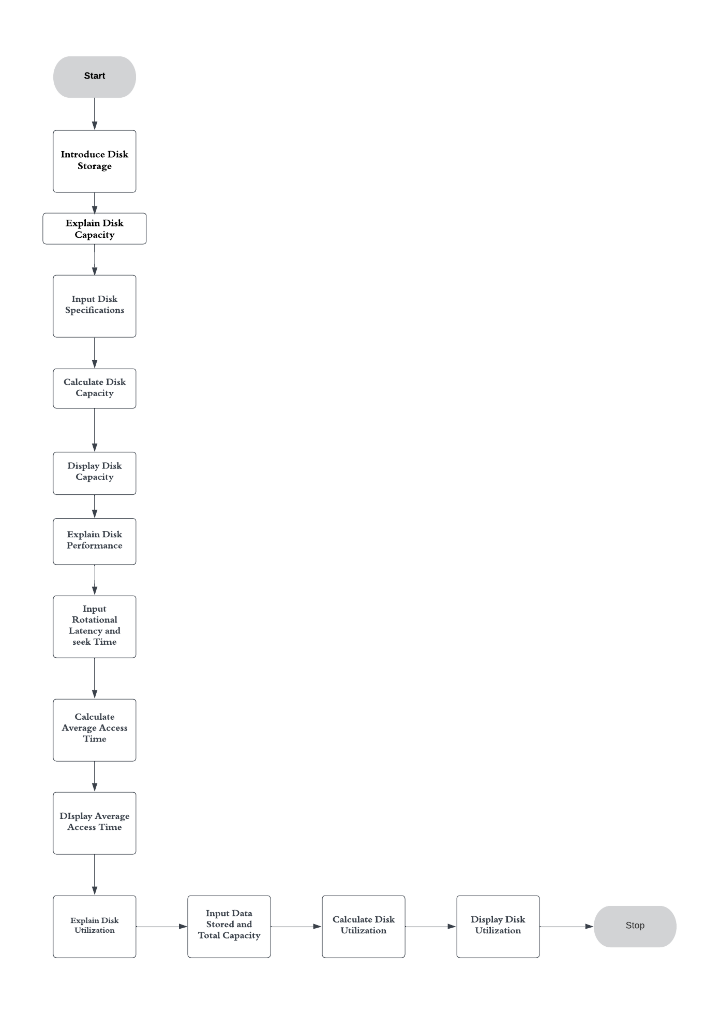
 Data Structure
Data Structure Networking
Networking RDBMS
RDBMS Operating System
Operating System Java
Java MS Excel
MS Excel iOS
iOS HTML
HTML CSS
CSS Android
Android Python
Python C Programming
C Programming C++
C++ C#
C# MongoDB
MongoDB MySQL
MySQL Javascript
Javascript PHP
PHP
- Selected Reading
- UPSC IAS Exams Notes
- Developer's Best Practices
- Questions and Answers
- Effective Resume Writing
- HR Interview Questions
- Computer Glossary
- Who is Who
Numerical on Disk
Numerics are essential for understanding the complex facets of disc storage since they offer a hands-on, practical method to grasp fundamental ideas. We may investigate how disc capacity, performance, and utilization are estimated by delving into numerical examples, helping us to understand the fundamentals of efficient storage management.
Example ? Think of a cloud service provider, for instance, that provides its customers with access to file storage. The service provider stores customer files, including documents, photos, and multimedia content, on disc storage. The disc storage system is built to support high data throughput and offers reliable file access.
In this article, we will explore Numerical on Disk, flowchart, and its use cases as well.
Flowchart of Disk

Use Cases of Disk
In many different settings and applications, disc algorithms are utilized to optimize disc access and storage. Disc algorithms are essential in the following usage cases?
File Systems ? To effectively manage and organize files on discs, file systems use disc algorithms. They choose the best spot on the disc to keep files, allot and reassign disc space, and streamline file retrieval and storage processes.
Database systems ? For effective data storage and retrieval, database management systems (DBMS) need disc algorithms. They aid in reducing disc I/O and enhancing overall database performance by assisting with data indexing, disc space management, and query processing optimization.
Caching Systems ? To increase the speed of data access, caching systems use disc techniques. To ensure the most pertinent and often used material is available in the quicker cache memory, they decide which data should be placed in the cache, prioritize frequently accessed or recently used data, and control cache eviction policies.
Data deduplication ? To find and get rid of superfluous data, data deduplication systems use disc algorithms. Disc algorithms can identify duplicate data chunks and store just one copy by employing strategies like content-based chunking and indexing, which result in significant storage space reductions.
Backup and recovery ? By streamlining data backup procedures, maintaining data integrity, and enabling effective data restoration, disc algorithms are essential to backup and recovery systems. They guarantee effective and dependable disk-based backup and recovery procedures.
Numericals
Q1. Consider a disk with 4 platters, 2 surfaces per platter, 1000 tracks per surface, 50 sectors per track, and 512 bytes per sector. What is the disk capacity?
Solution ? To calculate the disk capacity, we can follow these steps:
Step 1 ? Calculate the total number of tracks on the disk?
$$Total tracks = No.of platters * No.of surfaces per platter * No.of tracks per surface$$
$$Total tracks = 4 * 2 * 1000 = 8000$$
Step 2 ? Calculate the total number of sectors on the disk?
$$Total sectors = Total tracks * Number of sectors per track$$
Step 3 ? Calculate the total storage capacity of the disk
$$Total capacity = Total sectors * Number of bytes per sector$$
$$Total capacity = 400,000 * 512 = 204,800,000 bytes$$
Therefore, the disk capacity is 204,800,000 bytes or approximately 204.8 megabytes.
Q2 ? A storage system consists of 10 disk drives, each with 6 platters, 4 surfaces per platter, 2000 tracks per surface, 100 sectors per track, and 512 bytes per sector. What is the total capacity of the storage system? If 7 disk drives are currently filled with data, what is the overall disk utilization percentage?
Solution ? To calculate the total capacity of the storage system, we can follow these steps?
Step 1 ? Calculate the total number of tracks on each disk drive?
$$Total tracks = No.of platters * No.of surfaces per platter * No.of tracks per surface$$
$$Total tracks = 6 * 4 * 2000 = 48,000 tracks per disk drive$$
Step 2 ? Calculate the total number of sectors on each disk drive ?
$$Total sectors = Total tracks * Number of sectors per track$$
$$Total sectors = 48,000 * 100 = 4,800,000 sectors per disk drive$$
Step 3 ? Calculate the total storage capacity of each disk drive?
$$Total capacity = Total sectors * Number of bytes per sector$$
$$Total capacity = 4,800,000 * 512 = 2,457,600,000 bytes per disk drive$$
Step 4 ? Calculate the total capacity of the storage system?
$$Total capacity = Total capacity per disk drive * Number of disk drives$$
Total capacity = 2,457,600,000 * 10 = 24,576,000,000 bytesor approximately 24.58 terabytes
Therefore, the total capacity of the storage system is approximately 24.58 terabytes.
Now, let's calculate the overall disk utilization percentage ?
Step 1 ? Calculate the total capacity of the filled disk drives ?
$$Total filled capacity = Total capacity per disk drive * Number of filled disk drives$$
$$Total filled capacity = 2,457,600,000 * 7 = 17,202,200,000 bytes$$
Step 2 ? Calculate the overall disk utilization percentage:
Overall disk utilization % = (Total filled capacity / Total capacity of the storage system) * 100
$$Overall disk utilization percentage = (17,202,200,000 / 24,576,000,000) * 100$$
$$Overall disk utilization percentage ? 70.08% $$
Therefore, the overall disk utilization percentage of the storage system, considering 7 filled disk drives, is approximately 70.08%.
Conclusion
Numerical examples help us manage the intricacies of capacity, performance, and utilization by giving us a concrete and useful grasp of disc storage principles. We have learned how several elements, such as the number of platters, rotational latency, seek time, and data occupancy, affect the overall effectiveness of disc storage systems by partaking in these numerical exercises.

